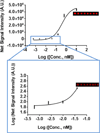Sensitive detection of protein and miRNA cancer biomarkers using silicon-based photonic crystals and a resonance coupling laser scanning platform
- PMID: 23963502
- PMCID: PMC4522268
- DOI: 10.1039/c3lc50579k
Sensitive detection of protein and miRNA cancer biomarkers using silicon-based photonic crystals and a resonance coupling laser scanning platform
Abstract
Enhancement of the fluorescent output of surface-based fluorescence assays by performing them upon nanostructured photonic crystal (PC) surfaces has been demonstrated to increase signal intensities by >8000×. Using the multiplicative effects of optical resonant coupling to the PC in increasing the electric field intensity experienced by fluorescent labels ("enhanced excitation") and the spatially biased funneling of fluorophore emissions through coupling to PC resonances ("enhanced extraction"), PC enhanced fluorescence (PCEF) can be adapted to reduce the limits of detection of disease biomarker assays, and to reduce the size and cost of high sensitivity detection instrumentation. In this work, we demonstrate the first silicon-based PCEF detection platform for multiplexed biomarker assay. The sensor in this platform is a silicon-based PC structure, comprised of a SiO2 grating that is overcoated with a thin film of high refractive index TiO2 and is produced in a semiconductor foundry for low cost, uniform, and reproducible manufacturing. The compact detection instrument that completes this platform was designed to efficiently couple fluorescence excitation from a semiconductor laser to the resonant optical modes of the PC, resulting in elevated electric field strength that is highly concentrated within the region <100 nm from the PC surface. This instrument utilizes a cylindrically focused line to scan a microarray in <1 min. To demonstrate the capabilities of this sensor-detector platform, microspot fluorescent sandwich immunoassays using secondary antibodies labeled with Cy5 for two cancer biomarkers (TNF-α and IL-3) were performed. Biomarkers were detected at concentrations as low as 0.1 pM. In a fluorescent microarray for detection of a breast cancer miRNA biomarker miR-21, the miRNA was detectable at a concentration of 0.6 pM.
Conflict of interest statement
BTC has founded a company with the goal of commercializing the PCEF technology. NA is employed by NanoInk, which commercially provides the DPN system used in this work.
Figures








Similar articles
-
High sensitivity automated multiplexed immunoassays using photonic crystal enhanced fluorescence microfluidic system.Biosens Bioelectron. 2015 Nov 15;73:32-40. doi: 10.1016/j.bios.2015.05.041. Epub 2015 May 19. Biosens Bioelectron. 2015. PMID: 26043313 Free PMC article.
-
Multiplexed cancer biomarker detection using quartz-based photonic crystal surfaces.Anal Chem. 2012 Jan 17;84(2):1126-33. doi: 10.1021/ac202817q. Epub 2011 Dec 29. Anal Chem. 2012. PMID: 22148758 Free PMC article.
-
Application of photonic crystal enhanced fluorescence to cancer biomarker microarrays.Anal Chem. 2011 Feb 15;83(4):1425-30. doi: 10.1021/ac102989n. Epub 2011 Jan 21. Anal Chem. 2011. PMID: 21250635 Free PMC article.
-
Nanostructured surfaces and detection instrumentation for photonic crystal enhanced fluorescence.Sensors (Basel). 2013 Apr 26;13(5):5561-84. doi: 10.3390/s130505561. Sensors (Basel). 2013. PMID: 23624689 Free PMC article. Review.
-
Photonic crystal enhanced fluorescence for early breast cancer biomarker detection.J Biophotonics. 2012 Aug;5(8-9):617-28. doi: 10.1002/jbio.201200037. Epub 2012 Jun 27. J Biophotonics. 2012. PMID: 22736539 Free PMC article. Review.
Cited by
-
Recent Advances in Biosensing With Photonic Crystal Surfaces: A Review.IEEE Sens J. 2016 May 15;16(10):3349-3366. doi: 10.1109/JSEN.2015.2429738. Epub 2015 May 5. IEEE Sens J. 2016. PMID: 27642265 Free PMC article.
-
Photonic Crystal Enhanced Microscopy on a 2D Photonic Crystal Surface.Adv Mater Technol. 2025 Mar 18;10(6):2401837. doi: 10.1002/admt.202401837. Epub 2025 Jan 8. Adv Mater Technol. 2025. PMID: 40786618
-
Activate capture and digital counting (AC + DC) assay for protein biomarker detection integrated with a self-powered microfluidic cartridge.Lab Chip. 2019 Dec 7;19(23):3943-3953. doi: 10.1039/c9lc00728h. Epub 2019 Oct 23. Lab Chip. 2019. PMID: 31641717 Free PMC article.
-
Lossy Mode Resonance Based Microfluidic Platform Developed on Planar Waveguide for Biosensing Applications.Biosensors (Basel). 2022 Jun 10;12(6):403. doi: 10.3390/bios12060403. Biosensors (Basel). 2022. PMID: 35735551 Free PMC article.
-
High-throughput imaging assay of multiple proteins via target-induced DNA assembly and cleavage.Chem Sci. 2015 Apr 1;6(4):2602-2607. doi: 10.1039/c4sc03809f. Epub 2015 Feb 11. Chem Sci. 2015. PMID: 29308164 Free PMC article.
References
-
- Basil CF, Zhao Y, Zavaglia K, Jin P, Panelli MC, Voiculescu S, Mandruzzato S, Lee HM, Seliger B, Freedman RS. Cancer research. 2006;66:2953–2961. - PubMed
-
- Zangar RC, Daly DS, White AM. Expert review of proteomics. 2006;3:37–44. - PubMed
-
- Srivastava S. Molecular diagnosis & therapy. 2006;10:221–230. - PubMed
-
- Masson S, Latini R, Anand IS, Vago T, Angelici L, Barlera S, Missov ED, Clerico A, Tognoni G, Cohn JN. Clinical chemistry. 2006;52:1528–1538. - PubMed
Publication types
MeSH terms
Substances
Grants and funding
LinkOut - more resources
Full Text Sources
Other Literature Sources

